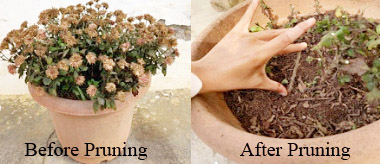
Jungshienla Jamir, Dr Ebibeni Ngullie, E Lireni Kikon
Modern chrysanthemum commonly known as ‘Glory of the East’ or ‘Mum’ has evolved as a result of endless variation and hybridization. The present number of varieties in the world is about 2000 and in India about 1000 varieties. Mums are classified under two categories: standard and spray type. In Nagaland, most homegrown mums are of spray type.
1. Pruning & Preparation of mother plant: Mums complete their blooms by end of January. Ultimately February becomes the perfect month to grab your secature and hard prune (cut) leaving a height of 7-15 cm above ground level. Gently loosen the soil around your plant and apply 2-3 handfuls of cow dung manure or compost per pot or 1 kg per plant in garden beds. This will help in healthy vegetative development and disease free cuttings.

2. Propagation: Mums are commercially propagated by cuttings. Take 5-7 cm terminal cuttings from mother plant, remove lower leaves, insert in coarse sand, keep in partial shade for 2 weeks and water 2-3 times a day. The best time for raising cuttings is during June- July.
3. Potting Media: Mums are highly sensitive to water logged conditions thus well drained potting media is essential (1 part garden soil: 3 parts FYM: 2 spoonfuls bonemeal/pot)
4. Planting time: Mums are transplanted during July-August when the cuttings attained 3-4 true leaves at a spacing 30x30 cm (plant to plant) for garden beds and 2-3 cuttings in a pot.
5. Feeding:

6. Watering: Water requirement will depend on climatic conditions and nature of potting media. Just remember not to keep the soil dry.
7. Intercultural practices:
i. Pinching: At 8-10 cm plant height, main stem tip (3-5 cm) is removed to encourage more side shoots.
1.1st pinching- 3rd week after planting
2. 2nd pinching - 5th week after planting
ii. Disbudding: Large growing bud is removed at pea size stage and side buds are retained for more blooms
iii. De-suckering: Remove side suckers periodically for proper growth of plants.
iv. Staking:To maintain proper shape and support weight of flower, staking is done using bamboo sticks.
8. Control measures on pests and diseases: Controlling pest and diseases in holistic approach with nature is desirable. Incase of aphids and thrips attack, spray neem oil @ 3 ml/litre of water 2 times a week. Keep yellow sticky trap @ 1 trap for 5 pots and 1 trap in every garden bed. Change the trap after 2 weeks or when the trap is fully covered with insects. In extreme cases, one can use chemicals like Imidacloprid @0.5ml/litre for aphids and thrips and Flubendiamide @ 0.5 ml/litre of water for leaf eating catepillars both at 15 days interval.
i. Leaf spot: Black spots on leaves; Foliar application of Chlorothalonil @ 2g/litre of water
ii. Rotting of roots: Roots rot and wilting of entire plant; Soil drenching with Copper oxychloride @ 2.5 g/litre of water
iii. Powdery mildew disease: Whitish spots on leaves; Spray wettable Sulphur @ 2g/litre of water
iv. Viral mosaic disease: Leaf curling and stunted growth; Spray Imidacloprid 17.8 SL @ 0.5ml/litre of water
9. Home remedies to prolong cut flowers vase life:
• Early morning hours are the best time to harvest cut flowers
• Do not place near the fire or under an electric fan circulsating hot air
• Timely mist blooms with clean and cool water
• End of flower stem should be cut every day under water and replace without exposing this again to air
• Little amount of sugar and copper sulphate added to the vase improve its keeping quality
Today with advancement of technology like using greenhouse for climate control and with expertise and resources, chrysanthemum cultivation is all set to go hi- tech. At present in India, growing chrysanthemum using the modern methods to alter photoperiod mechanism is at nascent stage and more entrepreneurs are now preparing to take up chrysanthemum cultivation in polyhouse.




